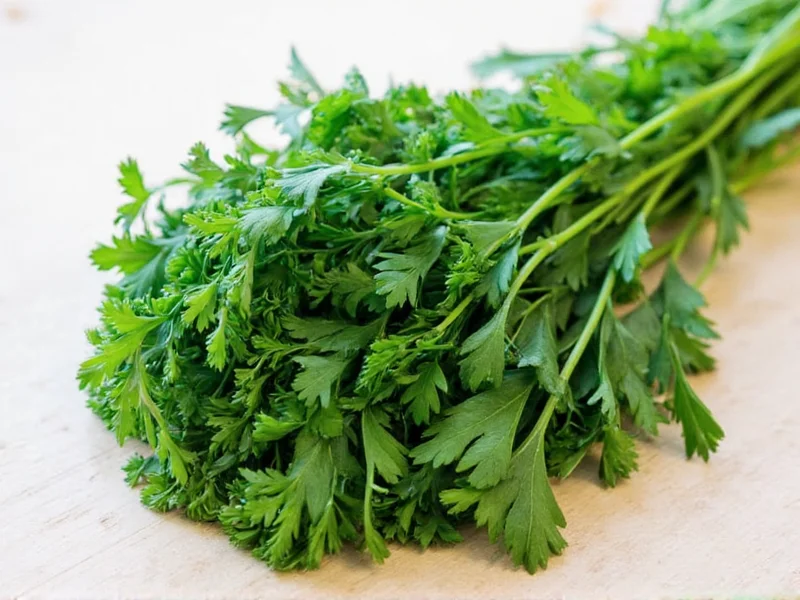Drying parsley at home transforms your fresh herb harvest into a shelf-stable seasoning that maintains flavor for months. Whether you've grown an abundant crop in your garden or purchased a surplus from the market, preserving parsley through proper drying techniques ensures you'll have this versatile herb available year-round for soups, sauces, and seasoning blends. This guide details three reliable methods that home cooks can implement with minimal equipment.
Why Dry Parsley at Home?
Fresh parsley loses its vibrant flavor within 1-2 weeks when stored in the refrigerator. Drying concentrates the herb's essential oils while removing moisture that causes spoilage. Home-dried parsley typically retains 70-80% of its original flavor compounds compared to store-bought dried versions, which often lose potency during commercial processing and extended shelf time. The process requires minimal equipment and transforms seasonal abundance into kitchen staples.
Preparing Parsley for Drying
Start with fresh, vibrant parsley harvested in the morning after dew evaporates but before heat intensifies. Look for deep green leaves without yellowing or wilting. Gently wash stems in cool water to remove dirt, then shake off excess moisture. Pat completely dry with clean kitchen towels — any remaining moisture can cause mold during the drying process. Remove thick woody stems but keep smaller stems attached to the leaf clusters, as they contain valuable flavor compounds.
Three Proven Drying Methods Compared
| Method | Time Required | Temperature | Best For | Flavor Retention |
|---|---|---|---|---|
| Air Drying | 7-10 days | Room temperature | Large harvests, no equipment | 85-90% |
| Oven Drying | 2-4 hours | 170°F (75°C) | Quick preservation | 75-80% |
| Dehydrator | 2-3 hours | 95°F (35°C) | Consistent results | 80-85% |
Air Drying Method: Traditional Technique
This chemical-free approach preserves maximum flavor but requires patience. Bundle 5-6 stems together with twine, ensuring leaves don't overlap. Hang bundles upside down in a dark, well-ventilated space with 40-60% humidity. A closet with good airflow works perfectly. Check daily for complete dryness — leaves should crumble easily when rubbed between fingers. This method takes 7-10 days but yields the most aromatic dried parsley. Avoid direct sunlight which degrades chlorophyll and essential oils.
Oven Drying Method: Fastest Home Technique
Preheat your oven to its lowest setting, ideally 170°F (75°C). Line a baking sheet with parchment paper and spread parsley in a single layer without overlapping. Prop the oven door open 2-3 inches using a wooden spoon to allow moisture escape. Check every 30 minutes, rotating the tray for even drying. Total drying time ranges from 2-4 hours depending on oven accuracy and parsley moisture content. The herbs are done when leaves crush easily and stems snap rather than bend.
Dehydrator Method: Most Consistent Results
Arrange parsley in a single layer on dehydrator trays, leaving space between stems for air circulation. Set temperature to 95°F (35°C) — higher temperatures risk cooking rather than drying the delicate leaves. Process for 2-3 hours, checking periodically after the first 90 minutes. Stir gently every hour to promote even drying. This method preserves the highest percentage of volatile oils compared to oven drying while being significantly faster than air drying. Most home dehydrators handle larger quantities than oven methods.
Proper Storage for Maximum Shelf Life
Complete drying is crucial before storage — any residual moisture causes mold. Test by placing a few leaves in a sealed container for 24 hours; if condensation appears, return to drying. Once fully dry, remove leaves from stems by rubbing between palms over a bowl. Store in airtight glass containers away from light and heat sources. Properly stored dried parsley maintains optimal flavor for 6-12 months. For extended preservation, add oxygen absorbers to containers and store in the freezer, which can extend shelf life to 18 months while preserving volatile compounds.
Using Dried Parsley in Cooking
Dried parsley has approximately three times the concentrated flavor of fresh. Use a 1:3 ratio when substituting — 1 teaspoon dried equals 1 tablespoon fresh. Add dried parsley early in cooking to allow rehydration and flavor infusion, unlike fresh parsley which is typically added at the end. It works particularly well in tomato-based sauces, soups, stews, and spice blends where prolonged cooking enhances its flavor release. For salad dressings or garnishes where fresh texture matters, reconstitute by soaking 10 minutes in warm water before use.
Troubleshooting Common Drying Issues
Problem: Parsley turns brown during drying
Solution: Temperature is too high or exposure to direct sunlight. Lower oven setting or move air-drying bundles to darker location.
Problem: Musty smell after storage
Solution: Incomplete drying before storage. Return to dehydrator for additional 30-60 minutes and ensure proper airtight container.
Problem: Loss of vibrant green color
Solution: Chlorophyll degradation from heat exposure. Use lower temperatures and avoid direct light during both drying and storage.











 浙公网安备
33010002000092号
浙公网安备
33010002000092号 浙B2-20120091-4
浙B2-20120091-4